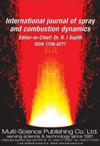泡腾式雾化器喷嘴出口区域气液流动特性的数值模拟
IF 2.1
4区 工程技术
Q3 ENGINEERING, MECHANICAL
International Journal of Spray and Combustion Dynamics
Pub Date : 2019-01-01
DOI:10.1177/1756827718821592
引用次数: 3
摘要
泡腾式雾化器喷嘴出口区域的压降和特殊的几何结构会引起复杂的流态变化,从而影响喷雾性能。本文对汽泡式雾化器喷嘴出口区域的气液两相流动特性进行了数值研究。结果表明,在不同的上游流型下,喷管出口区域的流动行为具有不同的特征。对于上游搅拌流,液膜形态与气液速度波动密切相关,出口段流动参数(流体速度和含气率)随时间有规律变化。对于上游气泡流,瞬时气体空隙率由混合室内气泡分布决定。在复杂的流场和表面张力的作用下,气泡会形成蝌蚪状。出口段的流动参数呈振荡衰减,波动幅度大于搅拌流。对于上游段塞流,气含率随时间变化显著。出口段气液流动参数的离散性非常明显。本文章由计算机程序翻译,如有差异,请以英文原文为准。
Numerical simulation of gas–liquid flow behavior in the nozzle exit region of an effervescent atomizer
The pressure drop and particular geometric structure of the nozzle exit region of an effervescent atomizer cause complex changes in the flow pattern, which could affect the spray performance. In this study, the gas–liquid two-phase flow behavior in the nozzle exit region of the effervescent atomizer was investigated numerically. The results show that the flow behaviors in the nozzle exit region have disparate characteristics with different upstream flow regimes. For upstream churn flow, the liquid film morphology is closely related to fluctuation in the gas–liquid velocity, and the flow parameters (fluids’ velocities and gas void fraction) at the exit section vary regularly with time. For upstream bubbly flow, the instantaneous gas void fraction is determined by the bubble distribution inside the mixing chamber. The bubble will form a tadpole-like shape as a result of the complex flow field and the surface tension. The flow parameters at the exit section are in an oscillatory decay, and the fluctuation amplitude is larger than for churn flow. For upstream slug flow, the gas void fraction varies significantly with time. The discrete characteristic of the gas–liquid flow parameters at exit section is very obvious.
求助全文
通过发布文献求助,成功后即可免费获取论文全文。
去求助
来源期刊

International Journal of Spray and Combustion Dynamics
THERMODYNAMICS-ENGINEERING, MECHANICAL
CiteScore
2.20
自引率
12.50%
发文量
21
审稿时长
>12 weeks
期刊介绍:
International Journal of Spray and Combustion Dynamics is a peer-reviewed open access journal on fundamental and applied research in combustion and spray dynamics. Fundamental topics include advances in understanding unsteady combustion, combustion instability and noise, flame-acoustic interaction and its active and passive control, duct acoustics...
 求助内容:
求助内容: 应助结果提醒方式:
应助结果提醒方式:


